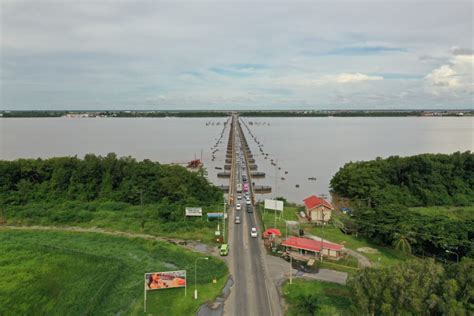The Demerara Harbour Bridge, located in Guyana, is a remarkable piece of infrastructure with a rich history. Here’s a detailed look at its story:
Planning and Construction
The idea for the Demerara Harbour Bridge emerged to address the growing need for a reliable connection between the East and West Banks of the Demerara River. Before its construction, ferries were the primary mode of transportation, which often caused delays and inefficiencies. The bridge was designed as a floating structure to accommodate the river’s tidal nature and the passage of marine vessels.
Construction began on May 29, 1976, with significant assistance from the British government. The design was spearheaded by Captain John Patrick Coghlan, and the bridge was built using approximately 80,000 tons of steel. It was completed in record time and officially opened on July 2, 1978, by Prime Minister Linden Forbes Sampson Burnham.
Features and Design
The Demerara Harbour Bridge is a floating pontoon bridge, one of the longest of its kind in the world. It spans approximately 1.85 kilometers (6,074 feet) and consists of 61 spans supported by 122 steel pontoons. Key features include:
- Retractor spans: These allow large vessels to pass through by creating a 77.4-meter-wide channel.
- High-span section: This provides a vertical clearance of 7.9 meters for smaller boats.
- Toll system: Tolls are collected for east-to-west travel, contributing to its maintenance and operation.
Economic and Social Impact
The bridge has been a game-changer for Guyana, significantly improving transportation and trade. It facilitates the movement of approximately 18,000 vehicles daily, connecting Regions 3 and 4 and fostering economic growth. It has also enhanced access to healthcare, education, and other essential services.
Challenges and Maintenance
Although initially designed to last only 10 years, the bridge has exceeded expectations and remains operational. Over the years, it has undergone several maintenance and rehabilitation projects to ensure its safety and functionality. In 2012, a section of the bridge collapsed during maintenance, highlighting the need for continuous upkeep.
Future Developments
Plans for a new Demerara River Bridge have been in the works, aiming to replace the existing structure with a modern, fixed bridge. This new project is expected to further enhance connectivity and support Guyana’s growing economy.

